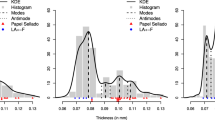Abstract
The spectral centroid of a signal is the curve whose value at any given time is the centroid of the corresponding constant-time cross section of the signal’s spectrogram. A spectral centroid provides a noise-robust estimate of how the dominant frequency of a signal changes over time. As such, spectral centroids are an increasingly popular tool in several signal processing applications, such as speech processing. We provide a new, fast and accurate algorithm for the real-time computation of the spectral centroid of a discrete-time signal. In particular, by exploiting discrete Fourier transforms, we show how one can compute the spectral centroid of a signal without ever needing to explicitly compute the signal’s spectrogram. We then apply spectral centroids to an emerging biometrics problem: to determine a person’s heart and breath rates by measuring the Doppler shifts their body movements induce in a continuous wave radar signal. We apply our algorithm to real-world radar data, obtaining heart- and breath-rate estimates that compare well against ground truth.
Similar content being viewed by others
References
Bizarro, J.P.S.: On the behavior of the continuous-time spectrogram for arbitrarily narrow windows. IEEE Trans. Signal Process. 55, 1793–1802 (2007)
Bizarro, J.P.S., Figueiredo, A.C.: The Wigner distribution as a toll for time–frequency analysis of fusion plasma signals: application to broadband reflectometry data. Nucl. Fusion 39, 61–82 (1999)
Chen, K.-M., Misra, D., Wang, H., Chuang H.-R., Postow, E.: An X-band microwave life-detection system. IEEE Trans. Biomed. Eng. 33, 697–701 (1986)
Chen, K.-M., Huang Y., Zhang J., Norman, A.: Microwave life-detection systems for searching human subjects under earthquake rubble or behind barrier. IEEE Trans. Biomed. Eng. 47, 105–114 (2000)
Chen, J., Huang, Y., Li, Q., Paliwal, K.K.: Recognition of noisy speech using dynamic spectral subband centroids. IEEE Signal Process. Lett. 11, 258–261 (2004)
Claasen, T.A.C.M., Mecklenbräuker, W.F.G.: The Wigner distribution—a tool for time–frequency signal analysis, Part II: discrete-time signals. Philips J. Res. 35, 276–300 (1980)
Claasen, T.A.C.M., Mecklenbräuker, W.F.G.: The Wigner distribution—a tool for time–frequency signal analysis, Part III: relations with other time–frequency signal transformations. Philips J. Res. 35, 372–389 (1980)
Cohen, L.: Time–frequency Analysis. Prentice Hall, Englewood Cliffs (1995)
Cooley, J.W., Tukey, J.W.: An algorithm for the machine calculation of complex Fourier series. Math. Comput. 19, 297–301 (1965)
Feichtinger, H.G., Gröchenig, K., Strohmer, T.: Efficient numerical methods in non-uniform sampling theory. Numer. Math. 69, 423–440 (1995)
Gajic, B., Paliwal, K.K.: Robust speech recognition in noisy environments based on subband spectral centroid histograms. IEEE Trans. Audio, Speech Lang. Process. 14, 600–608 (2006)
Gatesman, A.J., Danylov, A., Goyette, T.M., Dickinson, J.C., Giles, R.H., Goodhue, W., Waldman, J., Nixon W.E., Hoen, W.: Terahertz behavior of optical components and common materials. Proc. SPIE 6212(62120E), 1–12 (2006)
Gröchenig, K.: Irregular sampling, Toeplitz matrices, and the approximation of entire functions of exponential type. Math. Comput. 68, 749–765 (1999)
Massar, M.L.: Time–frequency analysis of terahertz radar signals for rapid heart and breath rate detection. M.S. Thesis, Air Force Institute of Technology (2008)
Petkie, D.T., Bryan, E., Benton, C., Phelps, C., Yoakum, J., Rogers, M., Reed, A.: Remote respiration and heart rate monitoring with millimeter-wave/terahertz radars. Proc. SPIE 7117(71170I), 1–6 (2008)
Schubert, E., Wolfe, J.: Does timbral brightness scale with frequency and spectral centroid? Acta Acustica United with Acustica 92, 820–825 (2006)
Seo, J.S., Jin, M., Lee, S., Jang, D., Lee, S., Yoo, C.D.: Audio fingerprinting based on normalized spectral subband moments. IEEE Signal Process. Lett. 13, 209–212 (2006)
Strohmer, T.: Computationally attractive reconstruction of bandlimited images from irregular samples. IEEE Trans. Image Process. 6, 540–548 (1997)
Author information
Authors and Affiliations
Corresponding author
Additional information
Communicated by Qiyu Sun.
Rights and permissions
About this article
Cite this article
Massar, M.L., Fickus, M., Bryan, E. et al. Fast computation of spectral centroids. Adv Comput Math 35, 83–97 (2011). https://doi.org/10.1007/s10444-010-9167-y
Received:
Accepted:
Published:
Issue Date:
DOI: https://doi.org/10.1007/s10444-010-9167-y




